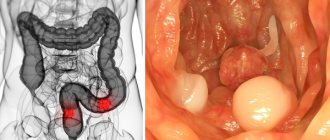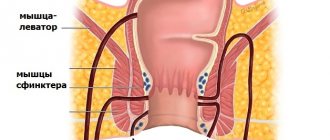How does colorectal cancer develop?
Oncology begins with the appearance in the body of just one altered cell that differs from normal ones. It is formed under the influence of various diseases, hereditary characteristics, bad habits and lifestyle, gradually multiplies and forms a tumor. Most of these cells are dealt with by the immune system - it identifies and destroys them, but some of them manage to elude the attention of our natural defenses. Over time, they enter the bloodstream and lymphatic system. The lymphatic system complements the cardiovascular system. The lymph circulating in it - the intercellular fluid - washes all the cells of the body and delivers the necessary substances to them, taking waste from them. In the lymph nodes, which act as “filters,” dangerous substances are neutralized and removed from the body. systems, with their help they spread throughout the body and disrupt the functioning of not only the digestive tract, but also other important tissues.
Almost all types of cancer begin in the mucosa, the inner lining of the rectal wall, and then spread layer by layer of the organ and beyond.
Types of Colorectal Cancer
Most types of oncology in this part of the digestive tract are adenocarcinomas
. They occur in cells that produce mucus that lubricates the inside of the colon and rectum.
In addition, there are other, much less common types of tumors:
- Carcinoid
: develop in cells that produce hormones - substances that are created by our glands, pass through the bloodstream to various tissues and tell them how to act - to work or rest, to secrete something or absorb something. - Gastrointestinal stromal
: begin in the so-called interstitial cells of Cajal, which set the rhythm of intestinal contractions. Some of them are not classified as cancer, but as benign formations - they compress the surrounding tissues, but do not penetrate them, and their cells do not spread throughout the body and do not create additional foci of the disease. - Lymphomas
are an oncology of the immune system. They arise in the lymph nodes, which retain and neutralize dangerous substances, the spleen, the bone marrow. Bone marrow is the spongy tissue inside some bones in which new blood cells are formed., thymus gland The thymus gland, or thymus, is a small organ located behind the upper part of the sternum in front of the heart , tonsilsTonsils, or tonsils, are organs located in the back of the throat that help produce antibodies - proteins that prevent inhaled or ingested microorganisms from multiplying. and the digestive tract. - Sarcomas
are tumors that can arise in the blood vessels, muscles, or other tissues of the rectal wall.
Late clinical picture of colorectal cancer
Progressive pathology is accompanied by:
- pathological discharge - in the stool there is not only blood and mucus, but also yellow or brown pus;
- pain - the tumor affects all layers of the intestine and spreads to adjacent organs.
If cancer develops in the anus and in the lower ampullary region, then pain occurs at an early stage of the disease. Moreover, it intensifies during bowel movements; patients complain that it hurts to sit.
In later stages, general oncological signs appear:
- weight loss;
- weakness;
- fatigue;
- irritability;
- insomnia;
- the skin takes on an earthy tint.
Features of the treatment of rectal cancer in Israel take into account the nature of metastasis of the cancer in advanced stages. At these stages, metastases develop in different organs, but most often in the liver, lungs, brain, spinal cord, bones, and adrenal glands.
Causes of colorectal cancer
Doctors and scientists do not know why exactly this type of cancer begins to develop, but they know about factors that increase the likelihood of this event:
- The risk of its occurrence increases with age
. It also occurs in young people, but most patients are over 50 years old. - polyps
in the digestive tract - tissue growths on its internal surface, especially if they are large in size or present in large quantities. - The chances are also increased for those who have ever had any type of colon
or
rectal
, even after they have been completely removed. - Smoking
, especially for a long time, harms not only the lungs. Tobacco smoke contains carcinogens - compounds that can provoke the development of life-threatening tumors in almost any part of the body. - Another important factor is heredity
. Most diagnoses are made to people whose family members have never had such tumors, but about 1/3 of patients have such relatives. - Diet : Lack of vitamin D, diets high in red foods such as
beef, pork, lamb or liver, and
processed meats
such as hot dogs, burgers and similar processed foods also increase risks. When they are cooked at high temperatures, chemicals are formed that can lead to the development of cancer. - Obese
people are more likely to develop cancer and die from it than those who watch their weight. - Alcohol consumption
, even in small quantities, contributes to the formation of various types of dangerous tumors. - Genetics -
approximately 5% of patients have inherited mutations - changes in genes that can lead to the onset of the disease, often at a fairly young age. - Inflammatory bowel diseases
, leading to long-term damage to its walls. They often provoke dysplasia - changes in the cells of the mucous membrane of the digestive tract, which over time can become cancerous. - Type 2 diabetes
- the body's inability to transfer glucose from the blood to tissue cells to obtain the energy they need increases the likelihood of developing cancer and dying from it. - Lack of physical activity
. The human body is created by nature for movement - it is thanks to it that all our systems and organs function correctly. In its absence, their work is disrupted, which leads to various failures, including the appearance of dangerous tumors.
Causes and risk factors
Currently, the mechanism that starts tumor growth is not fully understood, but oncologists have well studied the unfavorable factors that contribute to colorectal cancer. The most significant of them are:
- chronic inflammation of the mucous membrane;
- the presence of polyps in the colon;
- unbalanced diet with a predominance of red meat and a lack of plant fiber;
- inherited predisposition;
- obesity, sedentary lifestyle;
- presence of diabetes mellitus;
- lack of vitamins A, C and E, which block carcinogenic compounds in the intestines;
- smoking at least a pack of cigarettes per day;
- living in an environmentally unfavorable, polluted environment;
- age 50 years and older.
Symptoms and signs of colorectal cancer
As a rule, at the initial stage of the disease, a person does not notice any signs of health problems - they appear only after the tumor has grown and damaged a large number of tissues.
Possible symptoms of this type of oncology are as follows:
- Changes in bowel habits and frequency of trips to the toilet, prolonged diarrhea, constipation or an unusual shape of the stool - due to the increased growth of the stool, it may become narrow.
- Pain during bowel movements.
- Discharge of bright red blood from the anus.
- Weakness, drowsiness and fatigue.
- Unintentional weight loss.
- Feeling of intestines not being completely emptied.
- Blood or mucus in the stool, or a change in color to dark brown.
- Change in appetite.
- Cramps, gas, discomfort and pain in the abdomen.
- Iron deficiency anemia: lack of iron in the body. It is necessary for the formation of hemoglobin, a substance that allows oxygen to be transferred from the lungs to the tissues. This condition develops, among other things, due to bleeding in the digestive tract.
New symptoms appear when cancer spreads to other organs and forms metastases in them - additional foci of the disease:
- Edema that occurs when the lymphatic system is damaged. The lymphatic system complements the cardiovascular system. The lymph circulating in it - the intercellular fluid - washes all the cells of the body and delivers the necessary substances to them, taking waste from them. In the lymph nodes, which act as “filters,” hazardous substances are neutralized and removed from the body, which regulates the movement of fluid throughout the body.
- Enlarged liver, pain in the right side, as well as yellow discoloration of the skin, mucous membranes and whites of the eyes due to a violation of the outflow of bile, a liquid necessary for digesting food.
- Blood in the urine and changes in urination - the need for more frequent visits to the toilet, urinary retention and a weak stream when metastases appear in the bladder or prostate gland in men.
- Difficulty breathing and shortness of breath - a feeling of lack of air caused by damage to the lungs.
- Enlarged lymph nodes - organs of the lymphatic system that retain and neutralize harmful substances.
- Bleeding from the vagina in women with the development of additional tumors in the uterus, cervix or ovaries.
Periodic increase in temperature due to tumor disintegration.
Many of these symptoms can be caused by other conditions - infections, irritable bowel syndrome or hemorrhoids - enlarged vascular structures located in the lower part of the rectum. If you have any of the above health problems, be sure to see your doctor as soon as possible.
Diagnosis of rectal cancer
This procedure is necessary not only to identify the disease - the information obtained during it allows doctors to understand how seriously the body has been damaged and to select the most suitable therapy for a particular patient.
Oncology specialists conduct a full diagnosis of rectal cancer using the most modern equipment - quickly, efficiently, without delays or loss of precious time. The studies performed by us do not have to be redone - all medical institutions trust their results.
The examination begins with an examination and questioning about symptoms, well-being, past illnesses and family health problems, after which the doctor prescribes a number of procedures:
- Stool tests
, which may show the presence of blood in the stool. - Blood tests
: allow you to evaluate the number of red blood cells - cells that carry oxygen to tissues, as well as the quality of internal organs, such as the liver or kidneys.
In addition, they help identify tumor markers
- special proteins that indicate the presence of cancer in the body. This test is most often used to monitor patients who have already been diagnosed - its data shows how well the treatment is working. - Colonoscopy
is an examination of the intestine along its entire length using a thin flexible tube with a light source and a video camera at the end. - A biopsy
is taking tissue samples from suspicious areas and sending them to a laboratory, where a specialist will determine whether they are cancerous. - Ultrasound
- used to look for tumors in the liver, gallbladder, pancreas or other abdominal organs. By inserting an ultrasound probe into the rectum, the doctor can assess how far the tumor has grown through its wall. - Computed tomography
- used to evaluate the condition of the lymph nodes, liver or other organs. - Magnetic
resonance
imaging, MRI
- is used to detect metastases in the liver, brain and spinal cord. - Sigmoidoscopy
is an examination of the rectum using a short tube with a light and a small video camera at the end, which is inserted through the anus. The procedure allows you to determine the exact location of the tumor and measure it. - Angiography
is an X-ray examination of blood vessels that allows one to identify arteries supplying blood to liver tumors. - Positron
emission
tomography, PET
: a scan prescribed to search for additional foci of disease in the body.
For foreign citizens we offer a preliminary free consultation
Leading specialists of the Center will answer your questions.
To get a consultation
Find out the price
The rectum is the most terminal section of the digestive tube. It is a continuation of the large intestine, but in its anatomical and physiological features it differs significantly from it.
The fact that a pathological process is taking place in the final section of the intestinal tube is indicated by the appearance of polyps, adenomas, and inflammatory foci. , rectal cancer develops against their background . Treatment for this disease is usually successful, as the disease has been well studied. Even if it is neglected, a cure is possible if the therapy is carried out by qualified experienced oncologists.
According to world statistics, almost 800 thousand people are diagnosed with colorectal cancer every year. It ranks 4th in the global ranking of cancer diseases.
The disease most often occurs in patients living in developed countries. Their stable economy leads to a decrease in people's physical activity, and this leads to a high risk of developing obesity - and, as a result, to colon cancer. For example, in the USA, 145 thousand people are diagnosed with colorectal cancer every year.
In Belarus, rectal cancer most often affects men and people over 45, especially after 75 years.
Stages of rectal cancer
After identifying the disease, specialists determine its stage - find out how much tissue it has damaged and how far its cells have spread. This information allows doctors to provide an approximate prognosis for the patient and select the most appropriate treatment for him.
Staging is carried out according to the international TNM
, each letter of which has its own meaning:
- " T
" describes the size of the underlying tumor; - “ N
” indicates the number of affected lymph nodes; - “ M
” is used to denote metastases - additional tumors in organs located far from the rectum.
In total, doctors distinguish 5 stages
diseases:
0
, so-called cancer in situ: altered cells are found only in the mucous membrane of the organ.
I
: the tumor has reached the second or third layer of the intestine.
IIA
: the neoplasm has grown in the outer layer of the organ.
IIB
: oncology has spread beyond the rectum.
IIC
: the disease has damaged tissues located near the intestines.
IIIA
: one to six nearby lymph nodes are affected.
IIIB
: one to more than seven lymph nodes or surrounding adipose tissue are damaged.
IIIC
: The cancer has grown in the lymph nodes, surrounding fat, or other tissues closest to the main tumor.
IVA
: cancer has spread to one organ located far from the main focus of the disease - for example, the liver or lung.
IVB
: Additional tumors are found in more than one organ.
IVC
: damage to distant parts of the peritoneum - the lining of the abdominal cavity.
Oncoproctology department of the oncology center Lapino 2
Computed tomography (CT).
Rectal cancer.
This is a radiological method that visualizes the human body as virtual slices. In patients with rectal cancer, CT scanning of the chest, abdomen and pelvis can reveal affected lymph nodes and metastases in other organs (liver, lungs). For a better examination of the gastrointestinal tract, the patient drinks a contrast agent about an hour before the examination. Immediately before the CT scan, the colon is also filled with a contrast agent administered through the anus. This allows for good visualization of rectal tumors.
Treatment of rectal cancer
Fighting cancer is not an easy task. To solve it, the participation of a whole team of doctors is necessary - oncologist, surgeon, radiologist and many others.
Oncological treatment is carried out by world-class doctors using the most modern equipment - efficiently, quickly, without queues and loss of precious time. We fully guide the patient “from” to “to” - from examination to carrying out any necessary therapy, and give him a clear action plan, following which he gets the best result possible.
To treat rectal cancer, specialists use several methods, the main of which is surgery
. The type of intervention used depends on the stage of the disease, the location of the tumor and the purpose of the procedure. Some early forms of cancer and most polyps can be quickly and painlessly destroyed during a colonoscopy. Larger tumors require removal of part of the intestine, and possibly the tissue closest to it.
Some patients are prescribed special types of operations - the creation of an artificial opening through which stool is passed:
- ileostomy - its formation from fragments of the small intestine;
- colostomy - using a thick one.
A colostomy or ileostomy is brought out through an opening in the abdominal wall, after which a special bag is glued to the skin of the abdomen to collect feces.
Ablation
– destruction of tumors less than 4 centimeters in diameter using radio and microwaves, alcohol or cold. The procedure is used to remove small metastases, including those that reappear after surgery. This method prolongs life and alleviates severe symptoms of the disease in patients who cannot undergo surgery.
Embolization
– used to treat liver tumors. A special substance is delivered to a large vessel of the organ and blocks or reduces blood flow to the tumor.
Chemotherapy is drugs that destroy cancer cells. They are injected into a vein or taken orally, enter the bloodstream and act throughout the body. If necessary, they can be delivered only to specific parts of the body, minimizing side effects. This treatment is neoadjuvant
– prescribed before surgery to reduce the tumor and facilitate its removal, and
adjuvant
– carried out after surgery to destroy the oncology remaining in the body. In addition, the method is used to improve well-being and prolong life in the final stages.
Radiation therapy is the destruction of damaged cells using radiation. The procedure is often combined with chemotherapy and is prescribed to shrink the area of the lesion, eliminate any remaining cancer after surgery, prevent it from coming back, or relieve symptoms. It is also used when the disease spreads to other areas, such as bones, lungs or brain. Most often, external radiation therapy is prescribed - irradiation from a special device that affects the tumor through the skin. In some cases, brachytherapy is performed - placing a radioactive source in or near the tumor.
Immunotherapy
– drugs that help a person’s own immune system recognize and destroy dangerous cells. This method is suitable for patients with some forms of advanced rectal cancer. So-called immune checkpoint inhibitors turn off special proteins in altered cells that help them masquerade as healthy tissue and evade our natural defenses.
Targeted therapy
– drugs that work only against certain compounds in cancer cells. Some of them block the work of a protein that helps tumors create new blood vessels, which they need for nutrition and development. Others attack proteins that speed up the growth of abnormal cells. Targeted therapy prevents tumors from growing, reduces their size and prolongs life.
Advantages of the laparoscopic technique for total mesorectumectomy
- During the operation, there is a need to intersect nerve fibers, which can lead to urogenital disorders. To prevent such disorders, I use a nerve-sparing technique.
- In the presence of a widespread tumor or small-sized carcinoma, the operation is performed in several stages.
- To form the interintestinal anastomosis, I use modern staplers made in the USA, which helps to minimize the risk of developing postoperative complications, such as stricture or failure of the anastomotic suture.
- Using the LigaSure electrothermal tissue ligation device, ultrasonic scissors, and the Force Triad energy platform, mobilization of the colon is carried out quickly and bloodlessly, there is no need to use surgical clips and threads, and it is possible to preserve nerve fibers.
Considering the psychological state of patients when removing part of the intestine to the anterior abdominal wall, I strive, if possible, to perform organ-sparing operations while maintaining the continuity of the intestinal tube and rectal sphincter.
I have personally performed more than 300 laparoscopic interventions for diseases of the large intestine. The results of the operations are summarized in the monograph “Minimally invasive surgery of the colon.” Information about the surgical treatment methods I use can also be found in numerous peer-reviewed scientific publications.
Prognosis, survival and life expectancy for colorectal cancer
The prospects for each person are individual and depend on a huge number of factors - age, general health, type of disease, its neglect and response to treatment.
To present approximate forecasts, doctors use a special indicator - “five-year survival rate”. It says nothing about any individual patient's chances and only shows the percentage of people at a certain stage still alive 5 or more years after diagnosis.
For this type of oncology, these numbers look like this:
- at the localized stage, until the cancer cells have had time to damage anything other than the rectum - approximately 89%.
- at the regional level, when they spread to nearby tissues or lymph nodes - about 72%;
- with the formation of metastases - additional foci of disease in organs located far from the main tumor, such as the liver or lungs - 16%.









